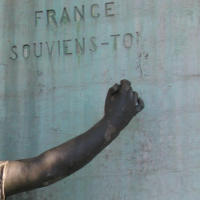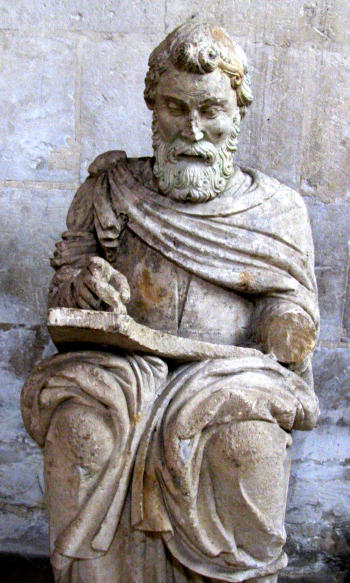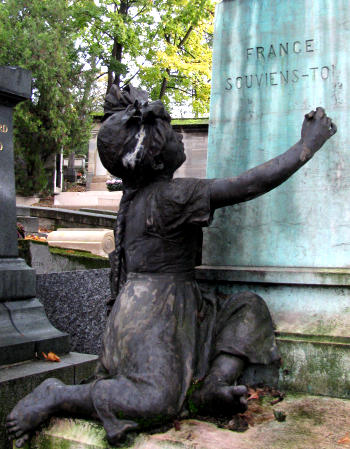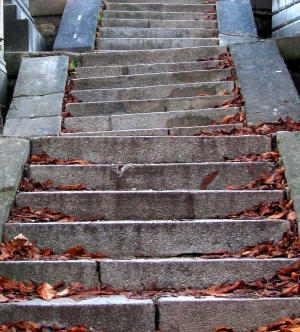
In November 2012 I was elected to the administrative board of the Association des journalistes du patrimoine (AJP), France’s Heritage Journalists Association, the first foreign journalist to join the board in the association’s 10 years of existence.
Declaring myself a candidate, i.e. showing up, was half the battle. It was also half the pride. It reflects my connection with an aspect of life in France that gets short shrift in most travel writing yet is a potential source of great fascination for foreign travelers and residents in France. I say “life in France” despite the fact that heritage calls to mind old stones and traditional ways because what interests me isn’t simply those stones and ways but the people who consider them (or don’t consider them) the building blocks, large or small, of their heritage, their patimoine.
In May 2012 I served on the jury of the annual Rubans du Patrimoine, a (très) French national competition that honors and awards prizes to villages and small towns for the restoration and use of heritage sites, preserved for their cultural importance. Occupied with seat on the jury reserved for the AJP, I was again the only foreign member.

Sitting on the jury among architects, restoration specialists, financial institutions, heritage organizations and journalists specialized cultural and heritage, I was initially intimated by the prospect of opining on the various projects. But I soon found my footing in the debate. The historical architects certainly knew better than I which elements were authentic features of which period; the restoration specialists were better judges of the quality of the workmanship; the bankers had a clearer picture of the economics of the projects. But I had a thing or two to say about how that heritage, however removed from my own, can be reused for government, community or tourism, and the importance of local engagement in a given project.
I am a generalist in writing about French patrimoine/heritage and I write about far more than that. France Revisited is not solely dedicated to the subject. Still, in explore life, travel, touring, culture and place in France in my own work and when editing the work of others, I find it important to have a sense of the role of patrimoine/heritage so as to avoid the falling into the tired clichés about France and the French that, whatever their truth or appeal, we’ve all heard a thousand times.
* * *
I apologize for reverting so often here to the French word patrimoine here rather than sticking with its English translation heritage, but “heritage” can be insufficiently evocative to American ears, beginning with my own. Perhaps Brits have a deeper sense of the word “heritage” in its communal or collective meaning. “Patrimony” is an alternate translation, but its scant use in English puts an ocean between it and the frequent or broad use in French of patrimoine. It’s worth noting that when speaking of one’s personal patrimoine the term refers to personal assets, to net worth and to one’s financial estate; there’s a bit of that in patrimoine/heritage as well.
The significance of the term patrimoine/heritage is naturally deep in a country that has remnants of 2000 years of heritage to mull over, to forget, to restore, to reject, to rehabilitate, to promote, to regret, to honor, to deal with, to finance, to debate, etc.
 The notion of patrimoine is deeply engrained in the consciousness of French adults. The term is used in reference to many of those aspects of France that foreign travelers and residents so enjoy about the country: cathedrals, castles, old mills, cuisine, vineyards, works of art, craftsmanship, language, stinky cheese and much else that has whose origins or methods or recipes are over, say, 50 years old.
The notion of patrimoine is deeply engrained in the consciousness of French adults. The term is used in reference to many of those aspects of France that foreign travelers and residents so enjoy about the country: cathedrals, castles, old mills, cuisine, vineyards, works of art, craftsmanship, language, stinky cheese and much else that has whose origins or methods or recipes are over, say, 50 years old.
Age alone does not make patrimoine. Put another way, since age can potentially make many things elements of heritage or patimoine, there are lots of competing interests at work to give recognition, which often means financing, to individual elements.
Patrimoine can be a reminder, an anchor, an echo, a ritual, a root, a tradition, some savoir faire, a ball and chain, or simply something that someone (not necessarily everyone) wants to preserve or honor in the name of continuity, beauty, memory, political or financial agenda, savoir vivre or community: international, European, national, regional, local, philosophical, religious, linguistic, political or familial. That’s a lot of work for a single word!
Patrimoine is only partially a word to be understood. It’s also a word to be felt, which is why there are so many interpretations as to an individual’s or a community’s or the nation’s relationship with the elements of heritage.
Being a generalist may well be the best way for a foreign journalist to approach French patrimoine after all.
* * *
As much as I enjoy visiting heritage sites and encountering elements of local, regional, national, European or world heritage, the greatest insights come from meeting those involved with such sites and elements: the owner of a medieval ruin or of a German WWII gun battery; the craftsman restoring stained glass or the worker knocking in cobblestones; the winegrower describing the subsoil of his vineyards or the gardener at a major chateau talking about rabbits and snails; the president of an association fighting to preserve abandoned building slated for demolition or the author of a book about streets of Paris that have disappeared; the proprietor of a shop that sells products made by monks or the mayor of a village that would like to restore its public washhouse.
 With an eye and an ear out for patrimoine, I now find that it—the word and the concept—appears where I least expect it. This past week I attended the screening of a new documentary about the French Foreign Legion, “Ils sentaient bon le sable chaud… Les Légionnaires,” which will premier on French television (France 5) on Dec. 2 at 10 p.m. After the screening I met the Legion’s Commander, General Christophe de Saint Chamas, and during our conversation he referred to the Foreign Legion as element of French patimoine. Now how can I resist learning more about the Foreign Legion after that?
With an eye and an ear out for patrimoine, I now find that it—the word and the concept—appears where I least expect it. This past week I attended the screening of a new documentary about the French Foreign Legion, “Ils sentaient bon le sable chaud… Les Légionnaires,” which will premier on French television (France 5) on Dec. 2 at 10 p.m. After the screening I met the Legion’s Commander, General Christophe de Saint Chamas, and during our conversation he referred to the Foreign Legion as element of French patimoine. Now how can I resist learning more about the Foreign Legion after that?
I encourage all travelers to seek out those artisans, craftsmen, owners, promoters, protectors and practitioners of patrimoine/heritage when taking to the routes of France, even when the heritage in question doesn’t seem worth preserving.
Ask them “Why is this thing important?” and they’ll invariably respond, “It’s a part of our patrimoine.”
Ask them what they mean by that and prepare yourself to hear a vision of the world they live in—the world you’ve come to visit. What more can a traveler ask for!
© 2012, Gary Lee Kraut

